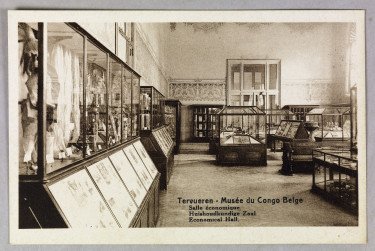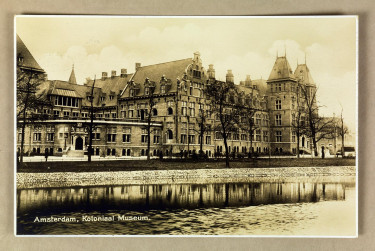The colonial museums

Legende
Musée du Congo Belge
The first colonial museums in France
In the 19th century, there were a number of colonial museums in the French regions (Lille, Lyon, Marseille, Nantes, etc). These institutions were attached to a chamber of commerce or higher establishment, which provided teaching. They were designed for an audience of students, teachers or professionals planning a career in agronomics or the administration in colonial areas. The products and objects on exhibit, presented by country and by category, came from economic agencies in the colonies, donations or exhibitions organised in the region. After they closed in the 20th century, the collections were sent to a natural science museum, ethnographic museum or university.
In Paris, a permanent colonial exposition had been set up in the Palais de l’Industrie, built in 1855 for the Universal Exposition. When it was demolished, just before 1900, there was talk of building a colonial museum that could rival its neighbours in London or Tervuren. So the French State considered an exposition of international scope, which would provide the opportunity to build a museum. World War 1, followed by the necessary planning period, delayed the project. The International Colonial Exposition opened in May 1931, around a decade after the one in Marseille (1922), with the "Musée Permanent des Colonies".
The great museums of Europe
The Tropenmuseum in Amsterdam
In Amsterdam, the Colonial Institute, inaugurated in 1926, followed an initial museum opened in 1871 in Haarlem. Devoted to the tropical regions (Indonesia, Surinam, Dutch East Indies), the museum served as the annex to a colonial institute dedicated to teaching and research. The complex was built by the Van Nieukerken architects, in brick, in a style reminiscent of the Dutch Renaissance. The building reflects the wealth of the colonies: its façades are decorated with eight bas-reliefs by the sculptor Louis Vreugde on the theme of raw materials (rubber, rice, sugar, tobacco) and religions (animism, Christianity, Hinduism, Islam), with the décor completed by friezes, sculptures (symbolic figures, royal portraits) and ironwork. The interior is organised around a huge central hall and three levels of galleries; Vreugde’s capitals portray an Indonesian legend and paintings on the upper part depict exotic scenes.

Legende
Amsterdam, Koloniaal museum. Carte postale reproduites par Stéphane Asseline.
Credit
Archives nationales, fonds Laprade
The museum was structured into three sections, corresponding to the institute’s scientific departments: ethnography (archaeological objects, everyday objects, paintings and sculptures), economics and statistics (animals, plants, textiles, mining resources, models, dioramas) and, to a lesser extent, hygiene. After the colonies gained independence, the museum was reorganised in the late 1970s and opened up to the entire world. The economic section disappeared and a new room was created on the topic of man and his environment. Today, the Tropenmuseum (Museum of the Tropics) covers the colonial past, traditional ethnography, along with contemporary social issues (immigration, traces of slavery). Adopting a deliberately outdated museography, the colonial history section presents the former museum in Haarlem, the personalities who lived in the colonies, represented by plexiglass mannequins placed under bell jars, dioramas and models. In contrast, a room on the topic of slavery questions our relationship with this painful aspect of history through multimedia displays. The Tropenmuseum covers several areas and today describes itself as a museum of world cultures.
London
In London, an Indian colonial museum opened its doors in 1880 in South Kensington. Following the success of the Colonial Exposition of 1886, the Prince of Wales decided to open a larger museum. The Empire Institute was built between 1887 and 1893 by the architect Thomas Colcutt in an eclectic style, featuring many towers, bell towers and arcades. Its objective was to develop trade and links with the British colonies. Its exhibition galleries displayed animals, plants, minerals, classified by territory; and all of this was complemented by arts and crafts, cards, paintings, statistics. After being placed under the authority of the Ministry of Overseas Trade in 1925, it was renamed the Commonwealth Institute in 1958 and moved to Holland Park; it closed its doors in 1971. The Colcutt building was demolished in the 1950s to allow for expansion of Imperial College.
The Tervuren museum in Belgium
In Belgium, an initial museum was designed on the occasion of the International Exposition of 1897, the colonial part of which took place in Tervuren, the former royal residence in the countryside near Brussels. Built by the architect Alfred-Philibert Aldrophe, the Palais des Colonies was then transformed into the Musée du Congo Belge, which opened in 1898. When the space became too cramped, King Léopold II decided to build a bigger one and called upon the architect Charles Girault, designer of the Petit-Palais in Paris, who adopted the same idea of a rectangular plan based around a huge central courtyard. The exterior presents a classic style; the interior, on the other hand, resembles a richly decorated palace, evoking colonial history: painted landscapes of the Congo; large geographic maps; allegorical sculptures in the niches of the central rotunda (themes of slavery and Belgium’s civilising mission).

Legende
Tervueren, Musée du Congo belge, façade principale. Carte postale reproduite par Stéphane Asseline.
Credit
Archives nationales, fonds Laprade
The Tervuren museum, inaugurated in 1910, had a dual mission: education of the masses and a propaganda tool for colonial ideas. The history of the Congo was told with an emphasis on the contributions made by colonisation (public works, transport, health, education, hygiene). Originally, it was structured into five sections, which were then reduced to three: economics, ethnography, natural sciences. The economics section spotlighted raw materials (rubber, ivory, wood, minerals), with products presented from their unprocessed state to ultimate transformation. The ethnographic section covered the life styles of the colonised populations and their art. The natural sciences section comprised four rooms dedicated to animals, minerals and entomology. To fulfil the museum’s educational role and make it more appealing, dioramas on animal or ethnographic topics were created. The architect designed a wide variety of display cases. After the Congo gained its independence, the museum changed administrative supervision and became the “Musée Royal de l’Afrique Centrale”. After it became too small and not very functional, a renovation programme was started in 2010, its centennial year; it was closed in 2013, then reopened in 2018 under the name Africa Museum.
The décor (murals, statues, marbles) and museographic furniture from the old museum were restored and most have been kept in the current presentation: large refurbished display cases containing colour photographs, desk-style display cases made of wood in the crocodile room with built-in frames, dioramas. The colonial past is covered in several sections (history of the museum, resource gallery, natural science gallery). Some items in the collections are presented from a different perspective as a way to inform visitors without shocking them: statues with racist connotations, for example, are penned in behind a barrier, like livestock, “forced out of the game”; or a display case devoted to the link between slavery and colonialism in the room on the colonisation of the Congo. In one of the galleries running alongside the courtyard, alongside a memorial that paid tribute to white men who died in the Congo, the Africans who died during the same period are honoured, as are those who died during the building of the 1897 exposition (the work of Congolese artist Freddy Tsimba).
The conversion of the Tervuren museum was a success, providing a reminder of the old museum while staying firmly rooted in the present day: it serves as three museums in one, natural history and ethnography, tribal art, and a museum of society covering environmental issues and migration. Using a variety of memorial and museographic approaches, it manages to reconcile today’s public with a painful history.
